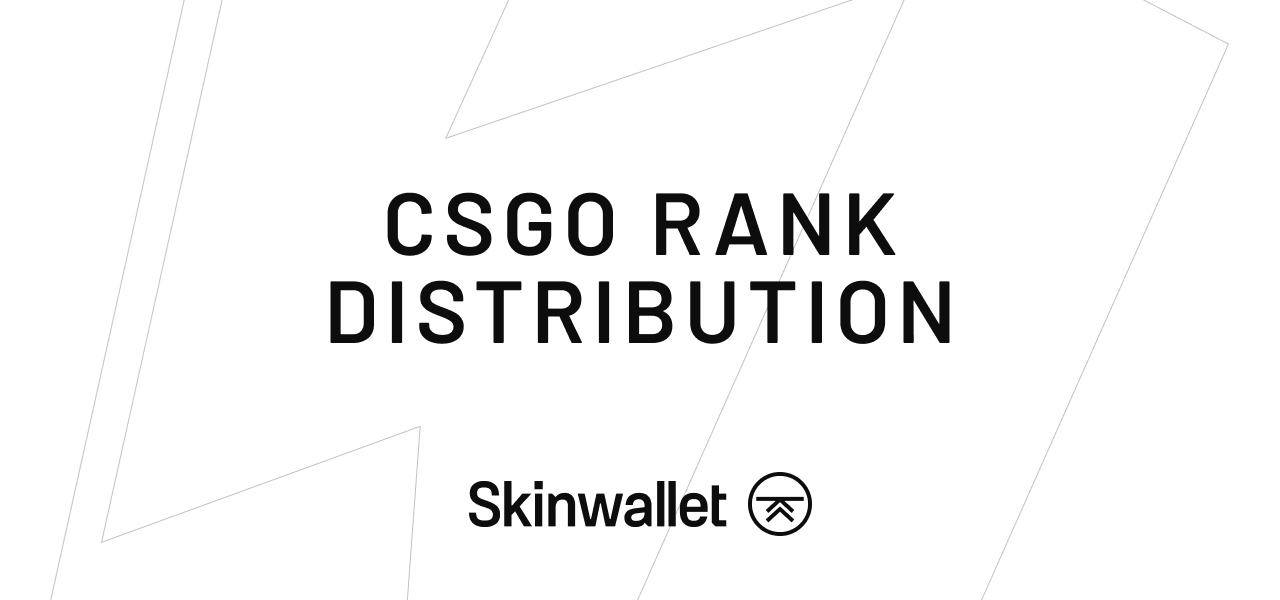CSGO Rank Distribution Explained

How many Global Elites are there in comparison to Silver I players? Let’s see if we can learn anything from CSGO rank distribution.
CSGO ranking system serves a very important purpose. In the realm of strongly skill-oriented shooters like Counter-Strike: Global Offensive, some sort of skill grading system is required to allow for smoother matchmaking. In other words, the beginning players have a less steep learning curve, the average players are more sure to find their equal, and the masters are not forced to suffer through opponents that don’t match their skill.
CS GO rank distribution is often a topic of discussion among the game’s fans. But why? Does the fact that there are more players in one skill group than the other tells us anything about the game? It actually can, as we’re about to show. First, let’s start with the current CSGO rank distribution and go on from there.
Competitive Rank vs Profile Rank
It’s important to discern the Competitive Rank and Profile Rank in CSGO. While the latter one is progressive, is more concerned with the XP gained since day 1 of Global Offensive playing, and allows users to receive a Prime access after some time, the former one is fluid and based on your performance in competitive matchmaking. This means that although you can have a high profile rank if your playing degrades, you can still fall in matchmaking. What we’re concerned about here is the competitive rank.
CS GO Rank Statistics
The matchmaking ranking method splits users into eighteen ranks, grouped into three different visual styles of the rank badge – Silver, Gold, and higher distinguished elites. They are assigned only after a given user reaches the second level of profile rank and plays 10 full matchmaking games, being initially assigned to Silver I rank. These mechanisms are most likely introduced to counteract smurf accounts and sift out cheaters. After some time, if the game’s algorithms decide you played enough matches that prove your skill, you will be assigned a new rank.
As of May 2021, the CS GO ranking distribution estimated by CSGO-Stats look like this:
Silver I Rank: 4.51%
Silver II Rank: 4.33%
Silver III Rank: 4.39%
Silver IV Rank: 5.37%
Silver Elite Rank: 6.70%
Silver Elite Master Rank: 7.70%
Gold Nova I Rank: 8.52%
Gold Nova II Rank: 8.81%
Gold Nova III Rank: 8.73%
Gold Nova Master Rank: 8.17%
Master Guardian I Rank: 7.39%
Master Guardian II Rank: 6.30%
Master Guardian Elite Rank: 5.25%
Distinguished Master Guardian Rank: 4.07%
Legendary Eagle Rank: 3.16%
Legendary Eagle Master Rank: 3.19%
Supreme Master First Class Rank: 2.61%
The Global Elite Rank: 0.78%
What Is The Average Rank In CSGO?
At this point in time, Gold Nova II is the most common rank among CSGO players. The Gold Nova I and III ranks are similar in number. One could easily say that there are more intermediate than beginner matchmaking players in CS:GO. Mind you, these stats don’t show any people who never received a rank, which means they never play competitively. However, there are less than 1% of Global Elites, which leaves them with less versatile competition to play with, but also shows how fragile of a position it is to keep up.
What Can We Learn From CSGO Rank Percentage?
There are a few conclusions we can draw from this rank distribution, but most of them are purely intuitive. First of all, some people say it’s much easier to gain the first few ranks up to Gold Nova, and only then the difficulty curve steps up. Also, with higher ranks, it’s easier to fall to a lower rank if you underperform for some time.
What Are Wingman Ranks?
The Wingman mode is a 2-on-2 ranked mode in CS:GO that is a faster playstyle with different dynamics than the Competitive mode. It received its separate ranking system because the skill required for Wingman matches is a bit different than the skill for the main mode. However, the ranks are all called the same. There is no available CSGO rank percentile for Wingman ranks, though.
Are There Danger Zone Ranks?
Yes, there is also a separate ranking system for the Danger Zone mode. Obviously, it’s a completely different game than standard CS:GO, except for the core mechanics of shooting and damage calculation – it’s a battle royale putting more emphasis on survival and hunting down your enemies. We’ve discussed the mode itself in this article if you want to catch up. The Danger Zone Ranks are as follows:
Unfortunately, there’s no rank distribution tracked for Danger Zone, maybe because the mode is not popular enough to present consistent data.
How To Rank Up in CS:GO?
It’s quite obvious that a bigger rank is not only a bigger challenge, but also bigger prestige among other players. If you feel like you deserve a better rank, your playing needs to reflect that.
The exact parameters of calculating the ranks are unknown – we can be sure that it uses a Glicko-2 system, but what is the detailed entry data coming from the game is Valve’s mystery. However, many observations have been made throughout the years, and here are some helpful tips that will increase your chances of going up the rank.
- Play for the team result, not for KDR. Garnering a lot of kills by the minimal amount of deaths is appealing, but remember that CSGO is a team game. You’re more likely to rank up if you’re playing together with your teamates for a better team score, not as a lone wolf.
- Befriend a pro. Sounds silly, but having a patient friend with a much higher rank who trusts your skills and is willing to play matches together is favorable. Remember to enter the same lobby first, otherwise, you’ll probably never end up in the same game!
- Focus on a smaller map pool. While it’s important to be versatile and learn strats for all maps in CSGO, your rating will benefit more from you playing well on three or four maps rather than playing average on all of them. If you are really determined to rank up, narrow down on the maps and focus on perfecting the tactics.
- Git gud. Your personal playing skills matter, because they will carry you through a variety of situations. Being a complacent and loyal teammate will do its lifting, but it will not drive you to Global Elite. Train your movement, learn your nades and crank up your aim!
- Take a deep breath. Maybe you’ve just lost a couple of games in a row. Maybe it’s just not your day. And that’s totally fine! It’s better to take a small break and start fresh than force it through and burn out.
CSGO Rank Distribution – Summary
With the available data, we were able to review and analyse the CSGO rank stats. The distribution can give us some insight into the dynamics of measuring CSGO skills. However, it’s important to approach all the conclusions on a light foot and use it as a booster towards your efforts in improving your skills.
If you have any other thoughts about CSGO ranks, please feel free to share them in the comments. In the meantime, wishing you some real good competitive matches!










